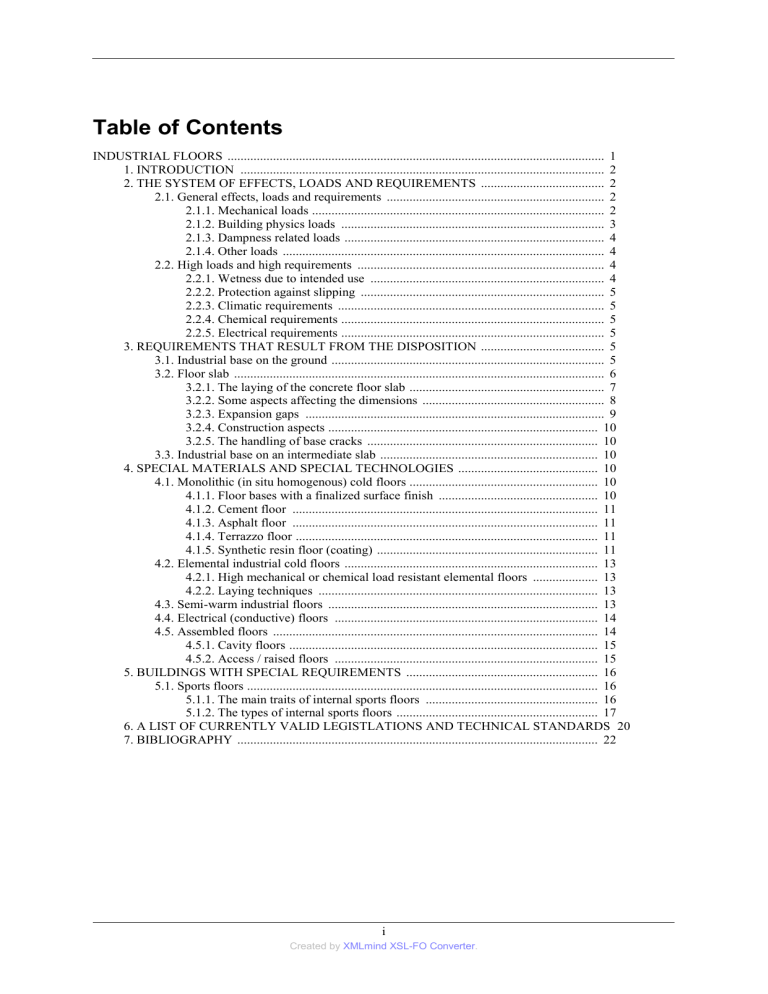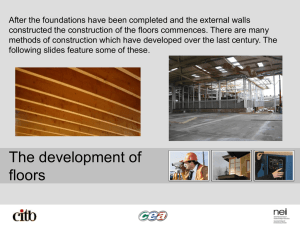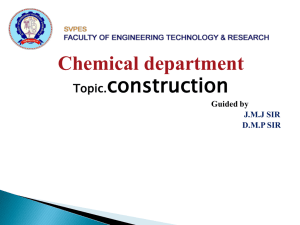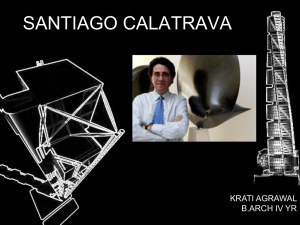2.1. General effects, loads and requirements

Table of Contents
2. THE SYSTEM OF EFFECTS, LOADS AND REQUIREMENTS ...................................... 2
3. REQUIREMENTS THAT RESULT FROM THE DISPOSITION ...................................... 5
4. SPECIAL MATERIALS AND SPECIAL TECHNOLOGIES ........................................... 10
4.2.1. High mechanical or chemical load resistant elemental floors .................... 13
6. A LIST OF CURRENTLY VALID LEGISTLATIONS AND TECHNICAL STANDARDS 20
i
Created by XMLmind XSL-FO Converter .
INDUSTRIAL FLOORS
professor univ.. Rita Pataky dr. Phd. assistant lecturer. László Kakasy demonstrator univ.. Ferenc Kuntner
Abstract
TÁMOP LECTURE NOTE TENDER
Focusing on the development of education, the development of educative materials and the training of teachers, with special attention to the fields of mathematics, natural sciences, technology in general and information technology in specific.
(Project no.: TÁMOP-4.1.2.A/1-11/1-2010-0075)
Intended for Budapest University of Technology and Economics, Faculty of Architecture students as a special addition to the Building Constructions 5 (Hall structures) and Building Constructions 6 (Industrial construction structures) subject material.
TÁMOP LECTURE NOTE TENDER
Focusing on the development of education, the development of educative materials and the training of teachers, with special attention to the fields of mathematics, natural sciences, technology in general and information technology in specific.
(Project no.: TÁMOP-4.1.2.A/1-11/1-2010-0075)
INDUSTRIAL FLOORS
Intended for Budapest University of Technology and Economics, Faculty of Architecture students as a special addition to the Building Constructions 5 (Hall structures) and Building Constructions 6 (Industrial construction structures) subject material.
preparation: BME Faculty of Architecture
Department of Building Constructions department head: Dr. Gábor Becker Phd. professor univ.
responsible: Rita Pataky professor univ.
1
Created by XMLmind XSL-FO Converter .
INDUSTRIAL FLOORS authors: Rita Pataky professor univ.
dr. László Kakasy Phd. assistant lecturer
Ferenc Kuntner demonstrator univ.
background information: dr. Gábor Lajos Takács associate professor univ.
English translation: dr. György Igaz invited lecturer read by (inside): Dr. Gergely Dobszay associate professor univ.
read by (outside): Dr. habil Lajos Kocsis associate professor univ. PTE PMMIK
1. INTRODUCTION
The term “industrial floors” in our understanding will describe floors with especially high loads upon them and will not only refer to the floors of factories and other industrial buildings in general. These high loads will typically generate special requirements (statical and dynamic loads, wear, moisture, chemicals, vibrations, continuity, germ free surfaces, cleanability etc.) and also high expectations which are to be considered above and beyond regular design rules.
Just as the “Floor structures” notes, the notes about industrial floors deal exclusively with internal floor structures. Both lecture notes are in close relation to each other. The first notes (Floor structures) describe requirements in general, investigate relationships and shows construction principles of “regular” floor compositions. The second notes (Industrial floors) will elaborate on the differences between the “regular” and the “industrial” floor and will describe the construction elements, layers, finishes, construction and calculation principles that are associated with increased loads. Naturally, architecture and design will not allow sharp margins in the differentiation, as a result, we may use solutions intended for high loads in general applications as well. Structural analysis and performance oriented design principles define that the designer bears the ultimate responsibility during these decision making processes.
2. THE SYSTEM OF EFFECTS, LOADS AND
REQUIREMENTS
For the design of any structure, it is imperative to know the expected loads and requirements. Known requirements will establish the selection of the appropriate structure, on the basis of its performance. Floors and other accessible areas in industrial, retail and transport functions are amongst the most used surfaces in any of our buildings. Due to all of the above, the aesthetically and technically adequate selection of these components is of a high importance.
2.1. General effects, loads and requirements
In the “Floor structures” lecture notes, II. section, loads, effects and requirements of the floors in general have been identified. In most cases the statements are also true for industrial floors, in some cases, however, there is a difference.
2.1.1. Mechanical loads
Floors structures must have an adequate load bearing capacity. For this to be achieved, calculations are to be based upon the expected useful loads of the given function. The loads may be:
• uniformly distributed,
• linear,
• space wise and time wise changing. This could mean static and dynamic loads:
• due to the nature and intensity of traffic,
2
Created by XMLmind XSL-FO Converter .
• vehicle loads,
• point loads,
• vibration loads,
• impacts.
uniform vehicle vehicle forklift shelves
INDUSTRIAL FLOORS figure 1. Loads on floor structures
Floor structure loads are calculated on the basis of regulations (EuroCode) and according to various functions, typically as evenly distributed weights. Unique loads, as shown above, are added, often on the basis of dedicated calculations.
Function Useful load ( kN/m2 ) residential, hotel, hospital parking slabs with personnel vehicle traffic schools, restaurants, libraries
2,0
2,5
3,0 lecture halls, theatres, cinemas, churches, waiting rooms, retail areas
4,0 museum, exhibition, public building corridors, 5,0 stages, dance halls, gymnasiums, with no further provision available: retail areas, parking slabs for trucks with no further provision available: warehouses 7,5 industrial buildings, forklift traffic e.g.: 3,5 ton forklift
10-30
12,5 table 1. Function related to useful load chart on the basis of EuroCode
The usefulness of the floors is reduced by wear loads (e.g.: shopping carts, forklifts) as these will cause unevenness and sometimes dusting. These are usually not allowed in the function space. Another important trait is the floor’s resistance to impacts, i.e.: its surface hardness.
2.1.2. Building physics loads
The function will define, whether the floor is to be furnished with thermal insulation or protection against water vapours.
In case of thermal protection, it is necessary to define the thickness of the insulation layer and its material.
Calculations should be made for large surface (appr. more than 20 m wide) buildings, to define the line and geometry of the thermal insulations.
Between spaces with different air conditions, or along the floors of cooled spaces, it is imperative to adequately protect the structure against water vapour loads.
3
Created by XMLmind XSL-FO Converter .
INDUSTRIAL FLOORS
Between the spaces of different functions, along the slab and floor lines, protection against the unwanted transfer of airborne and structure borne noises is to be inserted, if the industrial noise load and reverberations cannot be otherwise controlled.
Special attention is to be paid to the fabrication of floating floors, where the floatation layer must be selected with the expected loads in mind. If the useful load of the area exceeds 5kN/m2, then regular floatation layers cannot be used. Extremely high load areas (e.g.: the bases of heavy machinery) must be individually handled. In the latter case, spring supported floors are the typical solution.
2.1.3. Dampness related loads
Precipitation will usually not affect the floors discussed here, but some industrial building areas (covered, open stores, sheds) may still be temporarily exposed to rain and snow.
As shown for the general application, industrial floors must sometimes also be protected against ground moisture. This depends on the type of the floor finish and the internal function.
2.1.4. Other loads
In addition to the discussed general requirements, we will find conditions that also must be considered during the design process:
• protection against fire,
• wheelchair access
• geometrical-,
• fabrication (manufacturing)- and
• upkeep requirements.
2.2. High loads and high requirements
2.2.1. Wetness due to intended use
The intention of the insertion of protection against intended use related moistures is dual: on one hand, we need to protect the structural elements of the building and on the other hand, we must protect the neighbouring functional spaces. The performance levels are determined as shown in table no. 2.
Moisture load:
4
Created by XMLmind XSL-FO Converter .
INDUSTRIAL FLOORS table 2. Intended moisture load related protection levels
If in a single space, multiple load intensities may be expected, then all areas within that space are to be protected at the highest applicable protection standard. If the moisture load intensity is not uniform, but its level is to be considered high, then again, the higher applicable standard is to be used. Special attention is to be paid to moistures that result from substandard water quality. The composition of the water load may define not only the floor finish, but also the waterproofing technology used.
2.2.2. Protection against slipping
The need for safe and accident-free trafficking and working dictates that an appropriate non-slipping surface is to be selected as the floor finish. This is true both for wet and for dry conditions. Under wet conditions, primarily in a barefoot environment, there is a close relation between skidding and the proper drainage of the surface. When drainage is inadequate, the collected water will pool, producing a slippery surface. This surface will be slippery, even when it would otherwise be adequately adhesive. In a shoe wearing – primarily industrial
– environment, when oils, fats and other lubricating materials may soil the floor, the structure of the surface may provide protection against slipping.
2.2.3. Climatic requirements
Under this expression we mean requirements that aim to maintain airspace and surface temperature conditions that are not considered average. The floors under these conditions must also withstand sudden, transient or temporary loads, quick heat expansions or contractions and the resulting changes in the geometry.
2.2.4. Chemical requirements
In the case of all floors there is a limited need to withstand chemical exposure during cleaning, maintenance and natural use. As most would know, even the most perfect floor may be ruined by improper cleaning techniques.
On the basis of the intended use, therefore, we must search for potentially damaging chemicals, their dosage, concentration, exposure times and frequencies.
2.2.5. Electrical requirements
The build-up of electrical static charges is to be expected on both objects and living creatures. The effect will be a discharge, sparking which under certain conditions may lead to:
• explosion,
• the damaging of certain sensitive electronic devices etc.
The electrostatic build up will be limited by so called ESD (Electro Static Discharge) floor finish materials.
These materials, due to their composition
• will only collect a limited amount of static electricity, will be less likely to discharge
• will allow the draining of the collected energy via dedicated electronic solutions and thru the electrical system. Thus build up and discharge is avoided completely.
In some functions, the avoiding of spark may be a requirement.
3. REQUIREMENTS THAT RESULT FROM THE
DISPOSITION
3.1. Industrial base on the ground
One may ask, is there any need to protect industrial floors against humidity in the ground? This may only be answered thru the analysis of the internal functions and consequent dryness level requirements.
Internal space dryness requirements are:
5
Created by XMLmind XSL-FO Converter .
INDUSTRIAL FLOORS
• Total dryness is required for constant human occupancy and for moisture sensitive industrial technologies, or where moisture sensitive materials are stored. Where “dust” dryness is defined, the highest relative humidity value is to be considered, as given in the range for the particular function.
• Relative dryness means that some humidity may enter thru the construction, however, this may not affect the airspace conditions of the interior, as defined for regular use of the function, nor may it result with unhealthy conditions or faulty building components.
Total dryness requirement will, in all cases, be achieved thru watertight waterproofing.
3.2. Floor slab
figure 2.elastic floor slab foundation figure 3. theoretical floor slab layering
The floor slab is a type of floor foundation that is not part of the load bearing structure. The floor slab is severed from the structural frame and is applied when high statical and/or dynamic loads are expected.
The general layer composition of a floor slab on the ground level:
- surface reinforcement/wear layer/finishing layer
- concrete slab
- separation – slipping – insulation layer
- load transfer – load dispersion layer
- natural soil.
In order to reduce adhesion between the concrete slab and the load dispersion layer, a sliding-slipping layer may be inserted. Other tasks of the slipping layer are:
• the prevention of the cooperation of the concrete slab and the load dispersion slab
• the prevention of cracks,
• the prevention of the draining of the water from the concrete mixture during settling
• the prevention of ground moisture infiltration, when applicable.
6
Created by XMLmind XSL-FO Converter .
INDUSTRIAL FLOORS
The concrete slab is a continuous, flexibly founded, high load bearing industrial structure. The slab is statically independent from the load bearing structure of the building, thus it will not contribute to the carrying of loads or reinforcements.
figure 4.Floor slab and office section connection
3.2.1. The laying of the concrete floor slab
A. Non-reinforced concrete
Advantages:
• there is no problematic steel mesh to work around
• quick construction
• economical
Slab thickness will be defined on the basis of load categories, but a minimum of 14-32 cm is expected.
Expansion joints – in case of a non-sliding separation layer – are <7,5 m, in case of a sliding separator layer <10 m, the concrete should be at least C25/30 class.
B. Reinforced concrete,
Where cracks are not allowed, or the width of the cracks is limited beyond general expectations or bending forces are expected, reinforced concrete slabs are to be used.
B1. Regular reinforcement (dual mesh or rods)
Slab thickness will be defined on the basis of load categories, but a minimum of 14-28 cm is expected.
Expansion joints – in case of a non-sliding separation layer – are <12 m, in case of a sliding separator layer
<25m, the concrete should be at least C25/30 class. Continuous loads must not exceed 2 t/m2.
B2. Fibre reinforcement (plastic or steel fibres)
Advantages when compared to regular (steel) reinforcement:
• homogenous, three dimensional reinforcement;
• great resistance to bending and stretching forces;
• cracking is also limited;
• great energy absorption nature against both surface and concentrated impacts
• an especially long lifetime, there is no corrosion
• there is no need for construction base slab (for steelwork)as a pre-mixed, already reinforced concrete is used
7
Created by XMLmind XSL-FO Converter .
INDUSTRIAL FLOORS figure 5-6. auxiliary reinforcement
In all applications, auxiliary reinforcements are required where large loads are concentrated, as well as in corners, holes, cavities etc.
3.2.2. Some aspects affecting the dimensions
Amongst the loads on the floor slab, statical and dynamic loads are definitive. EuroCode lists these loads in categories A to G, on the basis of the function. Floor slabs are subject to another important effect: mechanical wear. Mechanical wear is grouped in exposure classes – these must also be considered during the design process.
When creating cement based structures, we must always consider the subsequent cracking of the material.
Design may be seriously influenced by the function tolerance towards allowed “cracking” magnitudes.
Exposure class
Wear load The type of expected load on the surface
Examples
1
.
XM1 moderate light and medium loads, exposition and retail spaces, pedestrian traffic, light intensity plastic, rubber, wood and textile traffic of vehicles with inflated industry, light machinery
8
Created by XMLmind XSL-FO Converter .
INDUSTRIAL FLOORS
3
.
2
.
Exposure class
Wear load The type of expected load on the surface
Examples wheels fabrication laundries, paint works
XM2
XM3 strong vehicle traffic with wheels of fabrication halls, storage halls, both inflated and solid rubber wheels logistics centres, refurbishment halls, car mechanics’ works very strong vehicle traffic with polyamide or elastomer wheeled forklifts steel industry, metal works, truck mechanics’ shops table 3. Exposure classes
Use class Requirements for the prevention of cracking
Examples
A moderate storage halls for non-sensitive materials, rough steel and wood work, steel construction manufacturing, agricultural machinery halls
B medium fine metal and wood work, plastic and rubber industry, storage halls, logistics centres, vehicle mechanics’ shops
C strict exposition and retail spaces, paper and textile industry, fine machinery manufacturing, food industry, high shelved storage halls table 4. Structural “crack” classes
3.2.3. Expansion gaps
Dilation and thermal expansion related expansion motions as well as contractions, and the resulting cracking must be allowed for in a controlled manner For this purpose, floor slabs are made with expansion gaps (joints).
A. Structural movement and expansion gaps
Structural movements (e.g.: settlement) or movements related to temperature changes (expansions and contractions) will be accommodated by joints intentionally inserted between adjacent structural or two building sections. The joint will be continued in space thru all components in the same location. On floor surfaces, dedicated joint profiles are to be inserted.
B. Expansion gaps
Movements resulting from load changes and temperature deviations need to be allowed for in the floor slab by expansion joints at all connecting structures, doors and at expansion zone boundaries. The statics designer will define the location of the zone boundaries.
C. Contraction gaps
Monolithic concrete structures are prone to contraction, cracks even before they are placed under loads.
Contraction cracking magnitude is influenced by:
• slab thickness
• the type and location of the supports
• the distance of contraction gaps, their situation, construction, method and type of the joint
• concrete composition, technology
• reinforcement
• construction environmental conditions
9
Created by XMLmind XSL-FO Converter .
INDUSTRIAL FLOORS
The distance of the cracks to each other is influenced by:
• the thickness and construction of the slab
• whether the separation layer is sliding
• construction environmental conditions
• temperature of the intended use environment
Contraction zone edges preferably should form a square, but even when rectangular, the side length ratios must not exceed 1:1,5. When using non-reinforced concrete, the maximum zone area must not exceed 60 m2 and the expansion gaps must not be further than 6-7,5 m away from each other. In all cases constriction gaps must be placed at internal (negative) corners, around pillars and at other cavities etc. in order to avoid unpredictable surface cracking. Contraction joints that allow more than 12 m continuous surface can only be constructed when reinforced concrete is used on a sliding base.
3.2.4. Construction aspects
During the construction of floor slabs, rigorous conditions are to be adhered to, in order to keep internal structural cracks and external surface micro-cracks to a minimum.
3.2.5. The handling of base cracks
Cracks may be divided into two major categories:
• cracks resulting from the contraction of the concrete, or cracks resulting from singular overloads – from now on referred to a stationary cracks
• cracks resulting from dynamic loads (vehicle traffic, movements caused by thermal changes etc.) that change in time in term of size, from now on referred to as moving cracks
A. Stationary cracks
Stationary cracks may be evaluated only after the thorough cleaning of the surface, when this is done, the necessary sealing and closing of the cracks is possible.
B. Moving cracks
Cracks that are less than 0,3 mm in width are to be closed, filled and a qualified gap-bridging surface finish system is to be used. Cracks that are wider than 0,3 mm are to be made receptive towards elastic filler materials.
3.3. Industrial base on an intermediate slab
Especially high loads may also be expected on intermediate floor slabs. In these cases, the floor slabs above the acoustically and/or thermally insulated layers are to be designed as elastically based floor bases (see section
3.2.) It is important to take the expected future geometry changes of the base into consideration.
4. SPECIAL MATERIALS AND SPECIAL
TECHNOLOGIES
4.1. Monolithic (in situ homogenous) cold floors
Amongst others, monolithic cold floors are: site manufactured homogenous or layered cold floors, in some situations without a surface finish layer. In the last case, the final external surface is the floor material itself.
4.1.1. Floor bases with a finalized surface finish
10
Created by XMLmind XSL-FO Converter .
INDUSTRIAL FLOORS
When the floors have no dedicated external finish layers, the base itself may still be covered by an array of materials. Consequentially, different wear resistance, roughness etc. may be achieved. The surface treatment will also influence adhesion, water dispersion, cleaning, dusting, as per the function requirements.
The surface treatment may be:
• brooming
• rubbing
• levelling
• sanding
• sprinkling
• wash-out
• hardening treatment for concrete floors:
• sprinkling of hard material on the surface
• liquid hardeners
• coloring treatment for concrete floors:
• special cement mixture additive
• adding pigments
• adding coloured aggregates
4.1.2. Cement floor
A layer that is created by laying cement mortar in a thickness of more than 2 cm. Cement floors are used in low quality areas as the surface will dust easily and thus difficult to keep clean. Nowadays it is used infrequently as cement based adhesive screeds have replaced it.
4.1.3. Asphalt floor
High melting temperature bitumen (75-80 ºC ) is mixed with mineral additives to form this floor type. Bitumen floors are laid in at least 30 mm thickness. Typical uses are: industrial floors for production, storage and car parking areas.
4.1.4. Terrazzo floor
Terrazzo is a mixture of hard crushed stone and concrete, that is poured onto the floor base in 15-30 mm thickness. The levelled material is sanded multiply, polished and treated with linseed oil in order to achieve the known shininess. White cement has replaced the traditional grey cement as the binder. White cement may be coloured to any desired color thru the addition of mineral pigments. Expansion gaps are to be inserted between every 6-8 m2 unified surface. As a latest development, synthetic resin based terazzos have appeared, allowing thicknesses as low as 6-15 mm and the use crushed glass as an additive.
4.1.5. Synthetic resin floor (coating)
Synthetic resin is a type of artificially made fluid, high molecule reactive resin that, with the addition of the proper reagent will solidify into a single super molecule. In the building industry we use heat-hardening
(thermosetting) epoxy resins.
Artificial resins that are used for floor finishes are:
- epoxy
11
Created by XMLmind XSL-FO Converter .
INDUSTRIAL FLOORS
- polyurethane
- polyester
- polymethyl-meta-acrylate.
Synthetic resin finishes (coatings) are crack-free, easy to wash, easy to clean, to disinfect and are dust-free.
However, synthetic resins are not tolerant to long term exposure to reverse water loads, water pressures or water vapour loads coming from the base direction. As a result, their application is limited to structures and surfaces that are protected from ground humidity. Vapour transmitting surfaces may only be used where the vapour load does not exceed the vapour transmission limit of the surfaces.
The types of artificial resin finishes are:
A. Impregnation figure 7. Impregnation
High solvent content, or water soluble, unfilled synthetic resin solutions are used to infiltrate into the pores of the foundation and to partially fill the capillaries. After the evaporation of the solvent (or of the water) and the setting of the resin, the upper surface (1-5 mm) becomes denser and thus will have reduced water and waterborne substance saturation qualities, however its resistance against mechanical and chemical exposures will not be increased.
B. The closing of the surface pores/foundation
The base resin or the low water content water soluble resin filter into the capillaries creating a thin (0,1-0,3 mm) layer that effectively lessens water and water-borne substance absorption. Wearing and dusting is also reduced.
C. Thin finish /protection figure 8. Thin finish
When an artificial, unfilled resin layer of 0,3-1 mm thickness is applied, the surface unevenness will not be significantly influenced, however, the appearance may change drastically. Surface pores are closed completely, wear resistance is greatly increased, watertightness and anti-corrosion is achieved. The material is usually applied in 2-3 thin layers, the upper being the coloured. Adhesion may be increased thru sand sprinkling.
D. Thick finish
The goal of the application of this 1,0-5,0 mm thick film is to create a surface that is highly resistant to both chemical and mechanical loads. The material will bridge gaps, as such it is watertight. The upper surface may have a smooth, shiny, or adhesive, structured. Typically a foundation layer and 2-3 filled upper layers are used, where the upper, finish layer is coloured. The material will even out the unevenness of the base to an extent.
12
Created by XMLmind XSL-FO Converter .
INDUSTRIAL FLOORS figure 9. Thick finish
E. Mortar floors
Mortar floors are a special subgroup of the contact screeds with synthetic resin binders. Their thickness is about
8-10 mm and as such, they form a thick load distribution and evening layer on the floor base. Mortar floors may form the finish in industrial applications. As an alternative they may be used as the primer surface for synthetic resin finishes (coatings).
F. Decorative finishes
Decorative artificial resin finishes are purposely designed to give special creative effects in the interior.
4.2. Elemental industrial cold floors
4.2.1. High mechanical or chemical load resistant elemental floors
In case of high mechanical and/or chemical loads, the following small element finishes may be used:
• pressed ground granite tiles (stone porcelain)
• clinker tiles
• ceramite tiles
4.2.2. Laying techniques
Laying techniques elaborated upon in the “Floor structures” notes are applicable for these tiles as well.
Lately a new technique has become popular: the laying of tiles with vibration technology.
Vibro-ceramics figure 10. The theoretical layers of Vibro-ceramics
The prepared base is covered with a min. 4 cm thick, ground-wet laying layer (the mixture of cement, sand and water), sometimes additives are also used. On top of this laying layer, a so-called “contact layer” is applied. The tiles are then laid, without tapping, onto the above described base, as a rule there are no gaps are made. The tiles may only be of a defined quality: pressed or shrink-limit burnt ceramics which have a less than 3% water absorption and a maximum dimension of 30 cm. The thickness of the tiles is defined by the expected loads, as this is in close relation to both dynamic and statical load bearing. A minimum of 14 mm thickness is usual. The levelled base is covered with tiles, then it is intensively settled with rolling or flat vibrators. As, due to the vibration, the cement solution comes thru the gaps between the tiles, the binding of both the base and the gap-fill is uniform. Any remaining gap is filled with either a cement solution or with a mixture of cement, water and quartz sand.
4.3. Semi-warm industrial floors
13
Created by XMLmind XSL-FO Converter .
INDUSTRIAL FLOORS
Lino, PVC and rubber are all suitable for industrial applications. Whether in a roll or in a tile format, these materials have good wear resistance qualities, are long-lasting and have a limited noise reduction capacity as well. If the surface is structured, the materials are anti-slip, when made continuous, they are also easy to clean.
For details, please refer to the “Floor structures” notes.
4.4. Electrical (conductive) floors
When selecting the right material and the right tools, for the given functional requirements, both accidents and damages may be prevented. Conductive materials (ECF) are typically used in:
• explosive work places, explosive material storage areas
• electrical workshops
• hospital Ops, labs
• in clean spaces (micro electronics, computers, fine mechanics, semi-conductors, CD, DVD manufacturing)
• high-tech labs
• medicine production etc.
figure 11. A schematic operation of the conducting floor
The typical application fields of Dissipative materials (DIF) are:
• the controlling of industrial production processes,
• the manufacturing of electro-mechanical materials, assembly
• special health functions
• computer rooms, computers
• general laboratory spaces
Antistatic materials (ASF) are typically used (in all spaces where static charges are to be avoided) in:
• offices,
• small-scale computer rooms,
• schools
The surface finish types are:
• cold floors (ceramics, stone, artificial resins),
• semi-warm floors (rubber, Lino, PVC).
4.5. Assembled floors
14
Created by XMLmind XSL-FO Converter .
INDUSTRIAL FLOORS
Assembled floors are constructed when there is a large amount of electrical wiring or ventilation ducting to be accommodated for above the floor slab. Assembled floors are also used, when wet technologies are purposefully avoided during the construction. The typical application is in offices, banks etc. Assembled floors may be constructed as both cavity (not possible to disassemble) or raised (may be taken apart) floors.
4.5.1. Cavity floors
Cavity floors are generally used when a large amount of cabling is to be laid, however, without an expressed need for constant monitoring of the assembly.
figure 12. The schematic of the cavity floor
Cavity floors may be assembled or poured. The base is supported by pre-fabricated braces placed at every 200-
600 mm, on site manufactured, or left-in blocks. The base may be:
• building sheets (gypsum, gypsum-fibre, steel), onto which (as if permanent forms were used) self levelling calcium-sulphate Screeds is poured;
• multi-layer, ready mad base, laid in a bind, made continuous
• singular, homogenous base with the gluing of the connecting edges
4.5.2. Access / raised floors
Raised floors are typically made where intensive wiring is paired with intensive monitoring and/or variability needs. Raised floors are typically fabricated onto steel supports in a 600x600 mm raster, the base is composed of dry, ready-made, finished, singular, self-carrying elements.
figure 13. The schematic of a raised floor
The elements are manufactured from various materials, on the basis of the expected loads:
- as wood based,
- metal (aluminium or steel) or
- fibre reinforced mineral plates.
The finish surface of the plates may be:
15
Created by XMLmind XSL-FO Converter .
INDUSTRIAL FLOORS
- ceramic tiles,
- natural stone tiles,
- anti-static surfaces,
- carpets, PVC, linoleum etc.
The clearing below the accessible area is variable and usually is between 60-1200 mm, in other words, there is a lot of space. The construction may be freely disassembled, without being damaged.
5. BUILDINGS WITH SPECIAL REQUIREMENTS
This section deals with a few emphasized functions and the associated floor constructions. We elaborate on the requirements and the design principles. Some of the functions are not considered “special” in our daily lives, however, they may still be challenging during design and construction, primarily due to unusual loads and unusual effects.
5.1. Sports floors
The most important component of any active, sports area is the floor, which, aside from accommodating the sports function without hindering sports performance, must be safe and visually and acoustically appealing. The design of such functions must seriously consider the appropriate floor construction.
As an additional problem, these “sports floors” spaces, rooms and buildings are often used for various other functions - besides sports. Such functions require different traits for the floor, in some cases the floor is to be protected during:
• expositions,
• dance occasions,
• concerts,
• social school occasions
Sports floors may be easily and well selected for a single known sport, however, no floor will be perfectly suitable for all indoor sports. Compromises need to be made thru the successful coordination of safety, performance and management issues.
5.1.1. The main traits of internal sports floors
The main traits may be divided into three sub-categories:
A. Biomechanical traits
Biomechanical traits of the sports floor will describe how the floor influences the physical condition and performance of the human, exercising the given sport:
• force absorption KA55 (the dampening of impact energy)
• adhesion/traction
• vertical dimension changes (StVv)
B. Mechanical traits
Mechanical traits will describe the non-biomechanical traits of the sports floor, such as:
• rigidity
• concavity (W500)
16
Created by XMLmind XSL-FO Converter .
INDUSTRIAL FLOORS
• ball reflection (BR – Ball Rebound)
C. Other traits
• the smoothness and levelness of the surface
• fire resistance min.: Efl,
• wear resistance
• endurance, lifetime
• impact resistance
5.1.2. The types of internal sports floors
table 5. The main types of internal sports floors
A. Point elastic sports floors
17
Created by XMLmind XSL-FO Converter .
INDUSTRIAL FLOORS figure 13. The theoretical disposition of spot elastic sports floors
Spot elastic sports floors are the most generally used sports floor constructions. They may be glued directly onto the appropriately primed base and will result with a comfortable, soft surface. The materials used are: foam under layer PVC, PUR, Lino. The typical thickness is between 3-15 mm.
B. Area elastic sports floors figure 14. The theoretical disposition of plane elastic sports floors
18
Created by XMLmind XSL-FO Converter .
INDUSTRIAL FLOORS
The typical trait of the surface elastic sports floor is that a spot-like load will create a large, concentric depression on the floor surface. The deformation will occur in a wide, appr. 500 mm circular area, far beyond the loaded surface (W500). The structural thickness is usually around5-15 cm.
Typical floor types are:
• swing-batten system,
• sandwich system.
figure 15. The swing-batten system figure 16. The sandwich system
C. Combined sports floors
19
Created by XMLmind XSL-FO Converter .
INDUSTRIAL FLOORS figure 17. The theoretical disposition of combined sports floors
The typical aspect of combined sports floors is that spot-like loads will crate large, concentric depressions around the loaded area, while the loaded area will be depressed minimally according to the shape of the load.
The surface is the combination of the spot-elastic floor, in other words, a spot elastic floor is laid upon the swing-batten or the sandwich system. The combined sports floor is the best internal sports floor. The typical thickness is around 5-15 cm. As a rule, just like the surface elastic floor, the combined floor will require ventilation, this is often provided mechanically, sometimes with the simultaneous heating of the floor. The cavity may prove to be acoustically disturbing (banging), this may be helped by the insertion of fibrous insulators.
D. Semi area-elastic sports floors figure 18. The schematic of the semi-plane elastic sports floor
A new generation sports floor is the semi area-elastic floor which is a technological improvement to the spotelastic sports floor. These floors have better depression qualities: they are flexible, flexibly soft floors. A descriptive quality is the concentric, small scale depression around the spot-loaded area. Within an R=100 mm area the depression is >0 mm. The floor may be directly glued onto the base, it forms a comfortable, soft surface. During the factory manufacturing of the semi-surface elastic sports floor, a thick EPDM (or other flexible under layer) is combined with plastic/glass fibres or with a metallic mesh in order to distribute the weight. The combination is covered with Lino, rubber, PVC or poured PUR finish. The typical thickness is around 8-20 mm.
6. A LIST OF CURRENTLY VALID LEGISTLATIONS
AND TECHNICAL STANDARDS
20
Created by XMLmind XSL-FO Converter .
INDUSTRIAL FLOORS
[1] MSZ 04-140-2:1991 Épületek és épülethatároló szerkezetek hőtechnikai számításai. Hőtechnikai méretezés
[2] MSZ-04-803/13 Építő- és szerelőipari épületszerkezetek. Lapburkolatok
[3] MSZ EN 548 Rugalmas padlóburkoló anyagok. A mintázatlan és a mintázott linóleum előírásai.
[4] EN 649:1996/A1:2003 és MSZ EN 649:1996/A1:2004 Rugalmas padlóburkoló anyagok. Homogén és heterogén poli(vinil-klorid) padlóburkoló anyagok. Előírás
[5] EN 685:2007 és MSZ EN 685:2008 Rugalmas, textil és rétegelt padlóburkoló anyagok. Osztálybesorolás
[6] MSZ EN 1081
[7] MSZ EN 12004:2002 Habarcsok és ragasztók kerámia burkolólapokhoz. Fogalommeghatározások és követelmények.
[8] MSZ EN 12354-2:2000 Épületakusztika. Épületek akusztikai minőségének becslése az elemek teljesítőképessége alapján. 2. rész: Helyiségek közötti lépéshangszigetelés
[9] MSZ EN 12466:1998 és MSZ EN 12466:2000 Rugalmas padlóburkoló anyagok. Mintázatlan és mintázott linóleum előírásai
[10] MSZ CEN/TR 13548 A kerámia burkolás tervezésének és kivitelezésének általános szabályai
[11] EN 13756:2003 Fa padlóburkolatok. Fogalommeghatározások
[12] MSZ EN 13813:2003 Eszrichek és padozati anyagok Esztrichhabarcsok. Tulajdonságok és követelmények
[13] MSZ EN 13845:2005 Rugalmas padlóburkolók. Szemcsézéssel javított, csúszásgátlású poli(vinil-klorid) padlóburkolók. Műszaki leírás
[14] EN 14041:2004 és MSZ EN 14041:2004 Rugalmas, textil és rétegelt padlóburkoló anyagok. Alapvető jellemzők
[15] MSZ EN 14231:2003 Természetes építőkövek vizsgálati módszerei. A csúszási ellenállás meghatározása ingás vizsgálóeszközzel (SRT értékek megadása)
[16] MSZ EN 14411 Kerámia burkolólapok. Fogalommeghatározások, osztályozás, jellemzők és megjelölés
[17] EN 14761:2006 és MSZ EN 14761:2006 Fa padlóburkolatok. Parketta tömör fából. Élkötegelt keskeny, széles és modul-parkettaelemek
[18] MSZ EN 14904:2006
[19] MSZ 15035-79
[20] MSZ 15601:2007 Épületakusztika
[21] DIN 4109 Schallschutz im Hochbau
[22] DIN 18032-2
[23] DIN 18560 Screede im Bauwesen 2004
[24] DIN 51097
[25] DIN 51130
[26] BGR 181: „Fokozott csúszásveszélyességű munkahelyek és munkaterek padozatai” irányelv
[27] GUV-I. 8527: „Mezítláb használt területek padlóburkolatai”
[28] A 28/2011 (IX. 06.) BM rendelettel kiadott Országos Tűzvédelmi Szabályzat
21
Created by XMLmind XSL-FO Converter .
INDUSTRIAL FLOORS
[29] 7/2006-os TNM rendelet „Az épületek energetikai jellemzőinek meghatározásáról”
[30] 2010/31/EU számú irányelv „Az épületek energiahatékonyságáról – Energy Performance of Buildings
Directive (EPBD)”
[31] 9/2008 (II.2.) OTM rendelet
[32] 253/1997. (XII. 20.) Korm. rendelet az országos településrendezési és építési követelményekről (OTÉK)
7. BIBLIOGRAPHY
[1] Szikra Csaba: Padlók hőveszteségének modellezése - előadás, Metszet Építési Megoldások Tervezői
Nap2011.05.05.
[2] Dr. Völgyesi Lajos: Geofizika, Műegyetem Kiadó, Budapest 2002.
[3] Fischer-Jenisch-Stohrer-Homann-Freymuth-Richter-Häupl: Lehrbuch der Bauphysik. Schall-Wärme-
Feuchte-Brand-Klima 6. Auflage Vieweg+Teubner Wiesbaden 2008.
[4] Dr. Gábor László: Épületszerkezettan IV., Nemzeti Tankönyvkiadó Budapest 1977.
[5] Pataky Rita: Energetical and constructional problemathic of post thermal insulation of floor constructions;
Konferenz „PAROPAS – 12” PORUCHY A OBNOVA OBALOVÝCH KONŠTRUKCIÍ BUDOV 07-
09.03.2012 Vysoké Tatry, Podbanské - hotel PermonISBN 978-80-553-0651-3 CD
[6] Pataky Rita: Padlók felépítése, szerkezetelemzés – előadás, Comfort Budapest Szakkiállítás és Konferencia
I. MAPEI Burkolástechnikai Konferencia 2012. 02. 17. SYMA Rendezvényközpont
[7] Dr. Preisich Katalin ÉPSZ4 előadásanyagai
[8] Pataky Rita BME Építészmérnöki Kar Épületszerkezettan4 előadásanyagai
[9] Pataky Rita BME Építészmérnöki Kar Épületszerkezettan5 előadásanyaga (letölthető: http://www.epszerk.bme.hu/index.php?id=C0106)
[10] BME Építészmérnöki Kar Épületszerkezettani Tanszék: Horváth Sándor: Üzemi-használati víz elleni szigetelések és Dr. Preisich Katalin: Padlók in: Épületszerkezettan 4. Tetőszigetelés, Belső térképző szerkezetek. Segédlet a BME Építészmérnöki Kar hallgatói részére. Készült „Az építész- és az építőmérnök képzés szerkezeti és tartalmi fejlesztése” HEFOP-pályázat támogatásával 2007. – letölthető: http://www.epszerk.bme.hu/index.php?id=C0105
[11] Ilyés László ÉMI: Padlóburkolatok akusztikai tulajdonságai - előadás. Comfort Budapest Szakkiállítás és
Konferencia I. MAPEI Burkolástechnikai Konferencia 2012. 02. 17. SYMA Rendezvényközpont
[12] Terjék Anita ÉMI: Bel- és kültéri padlóburkolatok csúszásgátlása - előadás. Comfort Budapest
Szakkiállítás és Konferencia I. MAPEI Burkolástechnikai Konferencia 2012. 02. 17. SYMA
Rendezvényközpont
[13] Brasnyó László: OTSZ 2011-28/2011(IX.6.) BM rendelet burkolatokra vonatkozó előírásai –
Burkolástechnikai Egyesület 2010.
[14] Alexander Unger: Fussboden Atlas; Fussböden richtig planen und ausführen – ISBN 3-00-006746-9 QUO-
VADO AG, Office Donauwörth 2004
[15] Talajnedvesség és talajvíz elleni szigetelések tervezési és kivitelezési irányelvei, ÉMSZ (Épületszigetelők,
Tetőfedők és Bádogosok Magyarországi Szövetsége) 2001.
[16] Dr. Balázs György: Építőanyagok és kémia. Tankönyvkiadó Budapest, 1984.
[17] Padló MI 01:2012 műszaki irányelv: ESZTRICHPADOZATOK. Tervezés, kivitelezés, követelmények.
22
Created by XMLmind XSL-FO Converter .
INDUSTRIAL FLOORS
[18] Pataky Rita: Burkolatok/padlószerkezetek hibái - előadás. MMK Építési Tagozat Tanfolyama Építési hibák. 2012. 05.017-18.
[19] Pataky Rita: Padlószerkezetek tervezési kérdései - előadás. Alaprajz Tervezői Nap 2009. 11. 12.
[20] Pataky Rita: Padlószerkezetek meghibásodásai. II. Épületszerkezeti Konferencia. Épület- és szerkezetfelújítás, kiadvány, szerkesztő: Horváth Sándor, Pataky Rita Budapest 2011. ISBN 978-963-313-043-8 pp50-54.
[21] Pataky Rita: Korszerű aljzatrendszerek, hidegburkolatok kialakítása - előadás. KNAUF csoport Tervezői
Ankét2008. 06. 24.
[22] Pataky Rita: Többfunkciós épületek nedves tereinek padlófelépítménye - előadás. Metszet Építési
Megoldások Tervezői Nap 2010. 06. 10.
[23] Pataky Rita: Hibákból okulva… - előadás, Metszet Építési Megoldások Tervezői Nap Paraméterspecifikus járófelületek 2011. 05. 05.
[24] Szentgyörgyi László: Szakszerű hideg- és melegburkolás, összhangban az európai (EN) szabványokkal – előadás (szakmai továbbképzés)
[25] Szentgyörgyi László: Szakszerű melegburkolás – előadás (szakmai kreditpontos képzés)
[26] Brasnyó László: Padlószerkezetek. Burkolatok – előadás, 2009.
[27] Dr. Dudás Annamária: 12. hét: Különleges padlószerkezetek. BME Építőmérnöki Kar Magasépítési
Tanszék Magasépítéstan MSC Kézirat 2010.
[28] Pataky Rita: Vibrokerámia in Építési Megoldások Burkolástechnikai Megoldások 2012/3. pp.10-13.
[29] BME Építészmérnöki Kar Épületszerkezettani Tanszék Haraszti Péter: Ipari műgyanta padlóburkolatok fejezete az Épületszerkezettan 6. Csarnoképületek, könnyűszerkezetek. Segédlet a BME Építészmérnöki Kar hallgatói részére. Készült „Az építész- és az építőmérnök képzés szerkezeti és tartalmi fejlesztése” HEFOPpályázat támogatásával 2007. (letölthető: http://www.epszerk.bme.hu/index.php?id=C0106)
[30] Csorba Gábor: Ipari betonpadlók - ÉPSZ5 keretében elhangzott előadás 2010.
[31] Műgyanta padlóbevonatok tervezése és készítése Műszaki irányelv. Készítette: Magyar Építőkémia és
Vakolat Szövetség (MÉSZ) 2012.
[32] Brasnyó László: Burkolatok elektromos tulajdonságai - előadás
[33] Brasnyó László: Vezetőképes hidegburkolatok - előadás. Comfort Budapest Szakkiállítás és Konferencia I.
MAPEI Burkolástechnikai Konferencia 2012. 02. 17. SYMA Rendezvényközpont
[34] Brasnyó László: Beltéri sportpadlók. Alaprajz Építész tervezői Nap. Járjunk Jól! – Korszerű padlófelépítések, speciális padlók. – Csanády Pál előadásában 2009. 11. 12.
[35] Dr. Reis Frigyes előadásai a BME Épületszigetelő Szak Akusztika tárgyból (letölthető: http://www.epitesz.bme.hu/page/1042)
BME Faculty of Architecture, Deparment of Building Constructions Industrial Floors
23
Created by XMLmind XSL-FO Converter .









